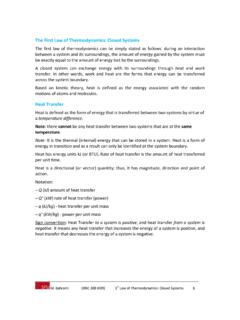Transcription of Chapter 7 – Energy and Energy Balances
1 CBE2124, Levicky 1 Chapter 7 Energy and Energy Balances The concept of Energy conservation as expressed by an Energy balance equation is central to chemical engineering calculations. Similar to mass Balances studied previously, a balance on Energy is crucial to solving many problems. _____ System A system is an object or a collection of objects that an analysis is done on. The system has a definite boundary, called the system boundary, that is chosen and specified at the BEGINNING of the analysis. Once a system is defined, through the choice of a system boundary, everything external to it is called the surroundings. All Energy and material that are transferred out of the system enter the surroundings, and vice versa. In the general case there are very few restrictions on what a system is; a system can have a nonzero velocity, a nonzero acceleration, and a system can even change in size with time.
2 An isolated system is a system that does not exchange heat, work, or material with the surroundings. If heat and work are exchanged across a system s boundary, but material is not, it is a closed system. An open system can exchange heat, work, and material with the surroundings. Examples. Discuss each situation below as approximating an isolated, a closed, or an open system. (i) A river. (ii) The interior of a closed can of soda. (iii) The interior of a closed refrigerator that is turned on. (iv) The interior of a closed refrigerator that is turned off. CBE2124, Levicky 2 State of a System Once a system is defined, a certain number of variables will specify its state fully. For example, one may need to provide the temperature, pressure, composition, total amount of material, velocity, and position in order to specify a system s state.
3 The exact information that is needed to specify the state of a system depends on the type of system and the analysis to be performed. State Functions and State Properties The state of a system can be changed, for example by increasing its temperature or changing its composition. Properties of the system whose change depends only on the initial (before) and final states of the system, but not on the manner used to realize the change from the initial to the final state, are referred to as state properties or state functions. In other words, the change in a state function or state property X, between some final (state 2) and initial (state 1) situations, can be expressed as 1 state2 stateXin changeinitialfinalXXXXX = 44 344 21 (1) In equation 1, Xfinal only depends on the final state of the system, and Xinitial only on the initial state of the system.
4 Equation 1 does not require any information whatsoever as to how the system got from the initial to the final state, since X does not depend on the details of the path followed. Example. Which of the below examples represent changes in state functions? (i) Work done to climb from the bottom (state 1) to the top (state 2) of a mountain. (ii) Change in gravitational Energy of an object when it is raised from the bottom (state 1) to the top (state 2) of a mountain. (iii) Change in density of water in a pot when it is heated from 20 oC (state 1) to 50 oC (state 2). (iv) Amount of heat liberated from burning gas in a stove in order to realize a temperature change of the water in a pot from 20 oC (state 1) to 50 oC (state 2). (This requires some thought.)
5 CBE2124, Levicky 3 Forms of Energy : The First Law of Thermodynamics Energy is often categorized as: A. Kinetic Energy B. Potential Energy C. Internal Energy Kinetic Energy A system s kinetic Energy is associated with directed motion ( translation, rotation) of the system. Translation refers to straight line motion. The kinetic Energy Ek of a moving object of mass m and travelling with speed u is given by, 221muEk= (2) Note that u is measured relative to a frame of reference that defines what is stationary . Ek has units of Energy , m of mass, and u of length/time. How could the kinetic Energy of a system change? Is kinetic Energy a state function? Potential Energy Potential Energy of a system is due to the position of the system in a potential field.
6 There are various forms of potential Energy , but only gravitational potential Energy will be considered in this course. The gravitational potential Energy of an object of mass m at an elevation z in a gravitational field, relative to its gravitational potential Energy at a reference elevation z0, is given by ()00mgzmgzzzmgEp = = (3) The quantity g is the gravitational acceleration that defines the strength of the gravitational field. Often, the earth s surface is used as the reference and assigned z0 = 0, in which case mgz represents the gravitational potential Energy of the object relative to its potential Energy if it rested on the earth s surface. pE has units of Energy , m of mass, g of length/time2, and z of length. CBE2124, Levicky 4 How could the gravitational potential Energy of a system change?
7 Is gravitational potential Energy a state function? Internal Energy All the Energy associated with a system that does not fall under the above definitions of kinetic or potential Energy is internal Energy . More specifically, internal Energy is the Energy due to all molecular, atomic, and subatomic motions and interactions. Usually, the complexity of these various contributions means that no simple analytical expression is available from which internal Energy can be readily calculated. The internal Energy will be represented by the symbol U. What types of events would bring about a change in a system s internal Energy ? Is internal Energy a state function? Enthalpy The enthalpy H of a system is defined by H = U + PV (4) where P is the pressure and V is volume.
8 Let s think about the PV term. We know that PA, where A is the area subjected to a pressure P, is the force acting on that area. If a fluid inside a system is displaced through a distance d by the force PA, then the resultant work W done on the system can be calculated as the product of this force times the displacement. In other words, W = PAd. Now note that Ad = V, the volume swept out by the displacement. Thus, an alternate way to write the displacement work is W = PV. This type of work, where pressure results in the displacement of a fluid, will be referred to as flow work. If an amount of fluid of volume V is inserted into a system against a pressure P, the work required to accomplish this is PV. Enthalpy, therefore, can be viewed as the sum of the internal Energy of this fluid volume added to the system plus the flow work performed on the system in order to insert the fluid.
9 Enthalpy has units of Energy ( J, cal, BTU). CBE2124, Levicky 5 What types of events would bring about a change in a system s enthalpy? Is enthalpy a state function? Specific Properties The total internal Energy , enthalpy, kinetic Energy , and potential Energy of a system are extensive properties. An extensive property depends on the total number of molecules present in the system and on the system s total size. Often, it is more convenient to refer to the amount of a property per mass of the system. For example, if the system is a fluid phase, one may want to express the amount of internal Energy or enthalpy contained in a unit mass of the fluid. If one refers to an amount of a property per mass, one is speaking about a specific property.
10 Specific properties are intensive. Thus, specific volume is volume per mass, specific internal Energy is internal Energy per mass, and specific enthalpy is enthalpy per mass. Specific properties will be identified by a ^ symbol above them; thus, V = specific volume (units: volume/mass; m3/kg, ft3/lbm), U = specific internal Energy (units: Energy /mass; J/kg, BTU/lbm), H = U + PV = specific enthalpy (units: Energy /mass; J/kg, cal/g), etc. Given a mass m of a uniform system with a specific property X , the corresponding extensive amount of X in the system is found using X = mX . How would you use this expression to calculate the extensive volume of a system? The extensive enthalpy of a system? Reference States The specific internal Energy and specific enthalpy of a material are always defined relative to a reference state.








